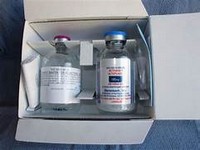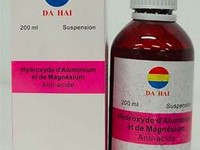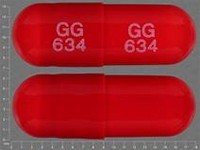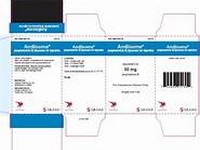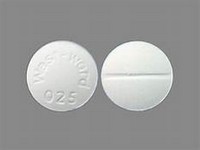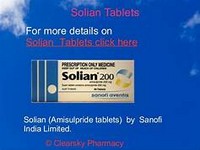Amiodarone hydrochloride
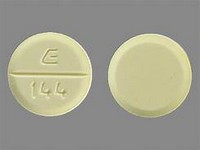
Amiodarone hydrochloride
CLINICAL USE
Cardiac arrhythmias
DOSE IN NORMAL RENAL FUNCTION
Oral: 200 mg 3 times a day for 1 week, then
twice a day for 1 week, then 200 mg daily
maintenance dose or minimum required
to control arrhythmia
IV: via central catheter – 5 mg/kg
(maximum 1.2 g in 24 hours)
Ventricular arrhythmias or pulseless
ventricular tachycardias: 300 mg over at
least 3 minutes
PHARMACOKINETICS
Molecular weight :
681.8
%Protein binding :
96
%Excreted unchanged in urine :
<5
Volume of distribution (L/kg) :
70–140
half-life – normal/ESRD (hrs) :
20–100 days/
Unchanged
DOSE IN RENAL IMPAIRMENT
GFR (mL/MIN)
20 to 50 : Dose as in normal renal function
10 to 20 : Dose as in normal renal function
<10 :
Dose as in normal renal function
DOSE IN PATIENTS UNDERGOING RENAL REPLACEMENT THERAPIES
CAPD :
Not dialysed. Dose as in normal renal function
HD :
Not dialysed. Dose as in normal renal function
HDF/high flux :
Unknown dialysability. Dose as in
normal renal function
CAV/VVHD :
Not dialysed. Dose as in normal renal function
IMPORTANT DRUG INTERACTIONS
Potentially hazardous interactions with other drugs
Anti-arrhythmics: additive effect and
increased risk of myocardial depression;
increased risk of ventricular arrhythmias
with disopyramide – avoid; increased
flecainide concentration – halve
flecainide dose; increased procainamide
concentration – avoid
Antibacterials: increased risk of
ventricular arrhythmias with parenteral
erythromycin, co-trimoxazole and
moxifloxacin – avoid concomitant use
Anticoagulants: metabolism inhibited
(increased anticoagulant effect)
Antidepressants: increased risk of
ventricular arrhythmias with tricyclic
antidepressants – avoid concomitant use
Anti-epileptics: phenytoin metabolism
inhibited (increased plasma concentration)
Antihistamines: increased risk of
ventricular arrhythmias with mizolastine
– avoid
Antimalarials: increased risk of
ventricular arrhythmias with chloroquine,
hydroxychloroquine, mefloquine and
quinine – avoid concomitant use; avoid
concomitant use with artemether/
lumefantrine
Antipsychotics: increased risk
of ventricular arrhythmias with
antipsychotics that prolong the QT
interval; increased risk of ventricular
arrhythmias with amisulpride, haloperidol,
phenothiazines, pimozide or sertindole –
avoid
Antivirals: increased risk of ventricular
arrhythmias with amprenavir, nelfinavir
and ritonavir – avoid concomitant use;
concentration possibly increased by
atazanavir; avoid with indinavir
Atomoxetine: increased risk of ventricular
arrhythmias
Beta-blockers, diltiazem, verapamil:
increased risk of bradycardia, AV block
and myocardial depression; increased risk
of ventricular arrhythmias with sotalol –
avoid
Ciclosporin: increased levels of ciclosporin
possible
Digoxin: increased plasma concentration
(halve digoxin maintenance dose)
5HT
3 antagonists: increased risk of
ventricular arrhythmias with dolasetron
– avoid concomitant use; caution with
tropisetron
Ivabradine: increased risk of ventricular
arrhythmias – avoid concomitant use
Lipid-lowering drugs: increased risk
of myopathy with simvastatin – do not
exceed 20 mg of simvastatin.1
Lithium: increased risk of ventricular
arrhythmias – avoid concomitant use
Pentamidine: increased risk of ventricular
arrhythmias – avoid concomitant use
Grapefruit juice: may increase
concentration of amiodarone – avoid
concomitant use
ADMINISTRATION
Reconstition
–
Route
Oral, IV via central catheter or
peripherally in veins with good blood flow
Rate of Administration
20–120 minutes (max 1.2 g in up to 500 mL
glucose 5% in 24 hours)
Comments
Add dose to 250 mL glucose 5%
Solutions containing less than 300 mg in
500 mL glucose 5% should not be used, as
unstable
Minimum volumes for central use only are
up to 900 mg in 48–50 mL.
OTHER INFORMATION
Amiodarone and desethylamiodarone
levels can be monitored to assess
compliance
In extreme clinical emergency, may be
given by slow IV bolus using 150–300 mg
in 10 to 20 mL glucose 5% over a minimum
of 3 minutes with close monitoring.
This should not be repeated for at least
15 minutes
Incompatible with sodium chloride 0.9%.
Rapid IV administration has been
associated with anaphylactic shock, hot
flushes, sweating, and nausea
See how to identify renal failure stages according to GFR calculation
See how to diagnose irreversible renal disease
Home

